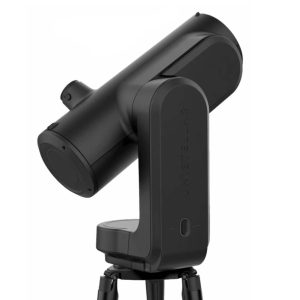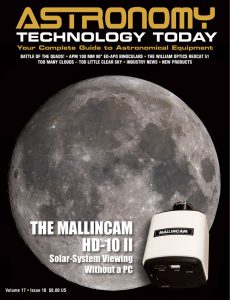The UniStellar Odyssey telescope is the latest iteration of the company’s automated smart telescope lineup. It comes in two different models, the base Odyssey and Odyssey Pro (shown in image) which is equipped with a digital OLED Nikon eyepiece for live views directly from the telescope.
 Both models of the UniStellar Odyssey telescope offer new technical advancements that distinguish them from other Unistellar models including the company’s new Multi-Depth Technology which provides optimal image capture of any celestial object through the use of imaging algorithms, resolution manipulation with binning and object-specific data processing. The result is an instrument that moves seamlessly from solar system planetary objects to deep sky wonders.
Both models of the UniStellar Odyssey telescope offer new technical advancements that distinguish them from other Unistellar models including the company’s new Multi-Depth Technology which provides optimal image capture of any celestial object through the use of imaging algorithms, resolution manipulation with binning and object-specific data processing. The result is an instrument that moves seamlessly from solar system planetary objects to deep sky wonders.
Each Odyssey model incorporates Newtonian reflector optics featuring an 85mm mirror, fast focal ratio of f/3.8, focal length of 320mm and a 4.1mp resolution imaging sensor. Overall, the UniStellar Odyssey technology provides a 34 x 45 arcmin field of view and 17.2 limiting magnitude.
The UniStellar app, available for iOS and Android, powers the Odyssey offering celestial databases, focus control and automated GoTo navigation all available wirelessly from a smart device.
The UniStellar Odyssey telescope specifications include:
– Focal Ratio: f/3.7
– Optical Design: Newtonian Reflector
– Aperture: 85mm (3.35″)
– Mount Type: Alt-Azimuth
– Focal Length: 320 mm
– Limiting Stellar Magnitude: 17.2
– Resolution: 4.1
– Integrated Wi-Fi: Yes
– Includes GPS Technology: Yes
– Objects in Telescope Database: 5,000+
– Battery Life Per Charge: 5 Hours
– Telescope OTA Weight: 8.8lb
– Tripod Weight: 5.5lb
– Total Weight: 14.3lb
You can learn more about the UniStellar Odyssey telescope models here.

 And to make it easier for you to get the most extensive news, articles and reviews that are only available in the magazine pages of Astronomy Technology Today, we are offering a 1-year magazine subscription for only $6! Or, for an even better deal, we are offering 2 years for only $9. Click here to get these deals which only will be available for a very limited time. You can also check out a free sample issue here.
And to make it easier for you to get the most extensive news, articles and reviews that are only available in the magazine pages of Astronomy Technology Today, we are offering a 1-year magazine subscription for only $6! Or, for an even better deal, we are offering 2 years for only $9. Click here to get these deals which only will be available for a very limited time. You can also check out a free sample issue here.
The Sun is more active than it’s been in years and if that’s not enough, we have the upcoming Total Solar Eclipse on April 8, 2024! If you’d like to learn more about the technology behind solar observing, solar imaging and more, you can check out our new monthly magazine – Solar Astronomy Today. It’s free to read, no subscription needed and available here. And if you are preparing for the upcoming eclipses and want to know your equipment options from solar glasses to the most out of this world solar viewing and imaging options, check out our free publication – The Definitive Guide to Viewing and Imaging the Sun – simply click here and enjoy reading!



